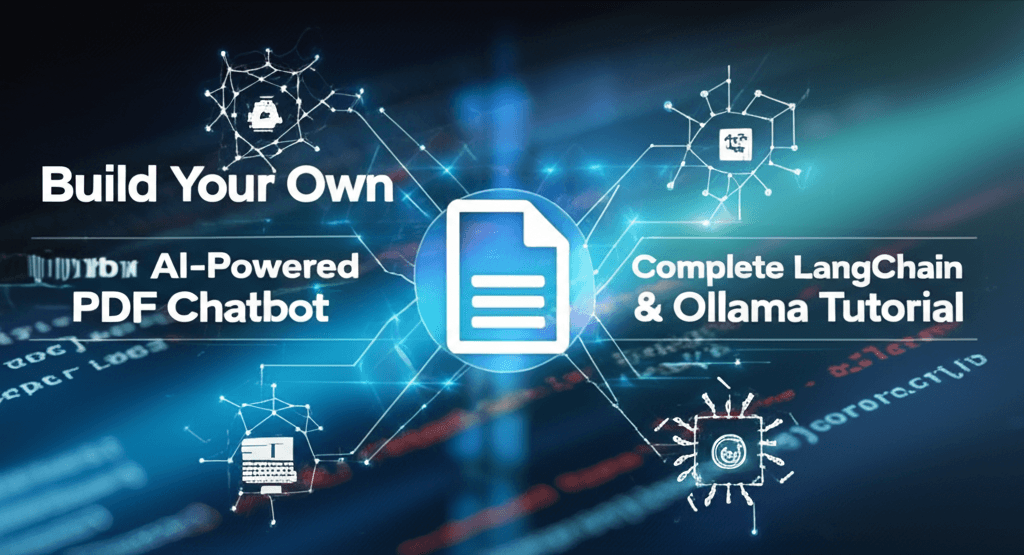Transform Documents Into Conversational Knowledge Bases With Local AI
Discover how to create an intelligent chatbot that unlocks the power of your PDF documents through natural language conversations. In this comprehensive guide, we’ll build a fully functional application using cutting-edge open-source technologies that runs entirely on your local machine—no cloud dependencies required. Perfect for developers exploring AI document processing, this tutorial combines three powerful tools: LangChain for conversational AI orchestration, Ollama for local language model processing, and Chroma as a lightning-fast vector database.
Our step-by-step approach will walk you through creating a Streamlit-powered web interface where users can upload PDF files, ask natural language questions, and receive accurate, context-aware responses. Whether you’re analyzing research papers, technical manuals, or business reports, this solution transforms static documents into interactive knowledge resources.
Why Build a Local PDF Chatbot? Key Benefits Explained
Modern document management requires smarter solutions than traditional keyword searches. With this AI-powered chatbot, you can:
- Ask Complex Questions: “What were the methodology limitations in this study?”
- Request Summarizations: “Explain the key takeaways from pages 15-20”
- Maintain Complete Privacy: Process sensitive documents without cloud exposure
- Reduce Costs: Eliminate API fees with free open-source models
- Customize Interactions: Modify prompts and retrieval parameters to your needs
This project demonstrates real-world implementation of Retrieval-Augmented Generation (RAG) architecture—combining semantic search with generative AI for contextually accurate responses. It’s particularly valuable for developers wanting hands-on experience with document chunking, vector embeddings, and conversational AI workflows.
Visual Walkthrough: See It in Action
Complete Toolkit: Technologies You’ll Master
- LangChain Framework: Orchestrates document loading, text splitting, and conversational memory
- Ollama: Runs powerful open-source LLMs like Llama 2 or Mistral locally
- Chroma DB: Embedding store for blazing-fast similarity searches
- Streamlit: Creates intuitive web interfaces with minimal Python code
- PyPDF: Extracts text from PDF documents for processing
Development Environment Setup Guide
System Requirements:
- Python 3.8+ environment
- Minimum 8GB RAM (16GB recommended)
- Ollama installed from official website
Package Installation:
pip install streamlit langchain langchain-ollama
langchain-community chromadb python-dotenv pypdfCore Workflow: How Your PDF Chatbot Processes Information
- Document Ingestion: Uploaded PDFs are parsed into raw text
- Chunk Optimization: Text is split into meaningful segments (experiment with 500-1500 character chunks)
- Vector Embedding: Ollama converts chunks into numerical representations
- Indexing: Chroma stores vectors for similarity searches
- Query Processing: Converts questions into vectors to find relevant document sections
- Response Generation: Augments retrieved content with LLM-powered answers
Expert Implementation Tips
- Chunking Strategy: Use recursive character splitting with overlap for context preservation
- Model Selection: Balance performance needs with hardware constraints (Llama 2 7B vs. Mistral 7B)
- Prompt Engineering: Customize system messages to refine answer quality and tone
- Performance Monitoring: Implement query logging and response validity scoring
Advanced Customization Options
Once you have the basic implementation working, consider enhancing your chatbot with:
- Multi-Document Support: Create knowledge bases across multiple files
- Source Citation: Show which document sections informed responses
- Hybrid Search: Combine semantic search with keyword matching
- Access Control: Add user authentication for sensitive documents
Troubleshooting Common Challenges
New users frequently encounter these issues:
- Incomplete Answers: Adjust chunk size or implement multi-hop questioning
- Long Processing Times: Optimize with GPU acceleration or smaller models
- Hallucinations: Increase retrieval documents and adjust temperature settings
- Formatting Loss: Implement text cleaning pipelines for complex PDF layouts
Next Steps: From Prototype to Production
Once your local implementation works successfully, consider deploying it as:
- Internal Knowledge Base: Help teams query company documents securely
- Educational Tool: Create interactive textbooks and research companions
- Customer Support Assistant: Answer questions from product manuals and FAQs
By mastering this technology stack, you’ll gain valuable skills in document AI processing that apply to countless real-world applications. The complete project shows how affordable, privacy-focused AI solutions can rival commercial alternatives when built with the right open-source tools.

Leave a Reply